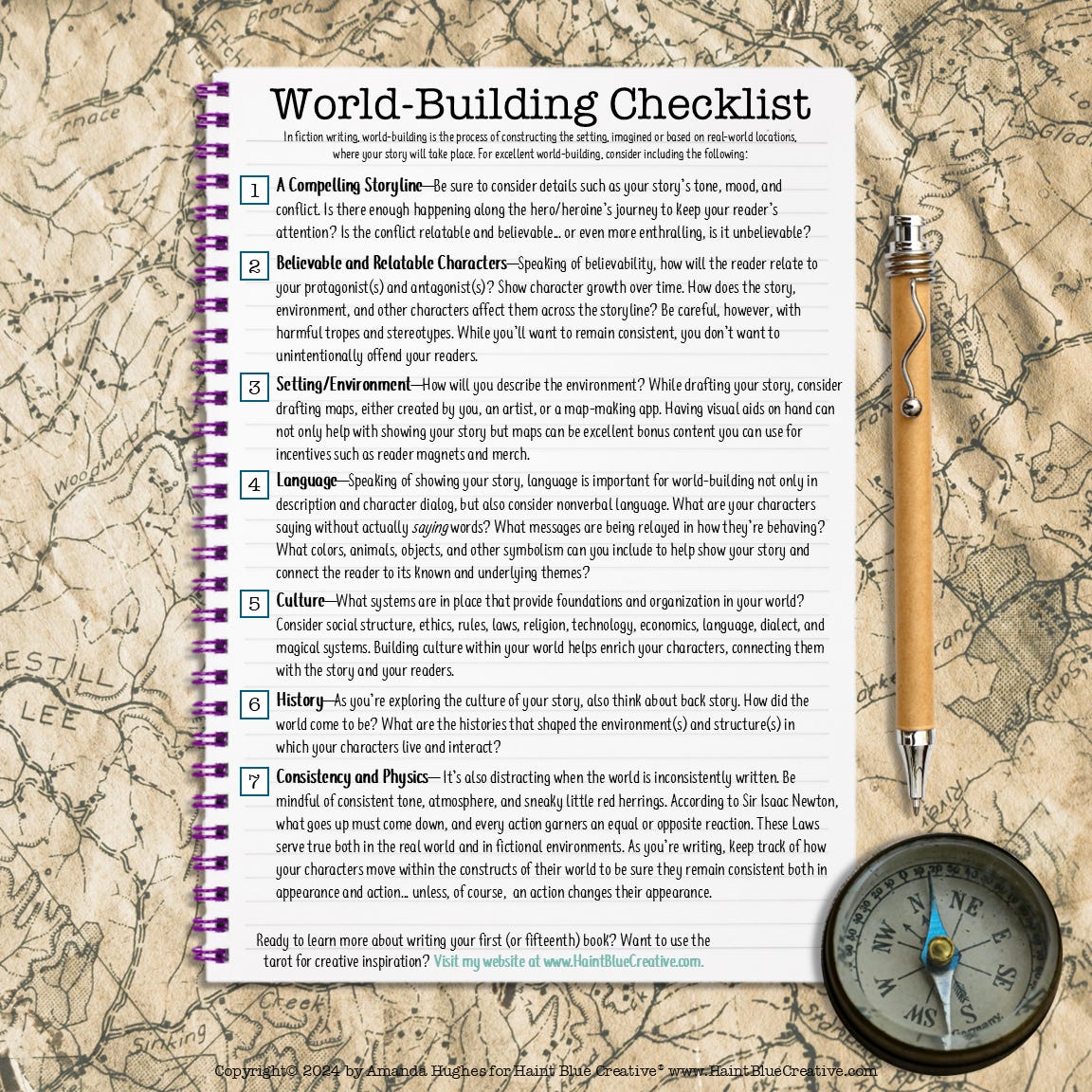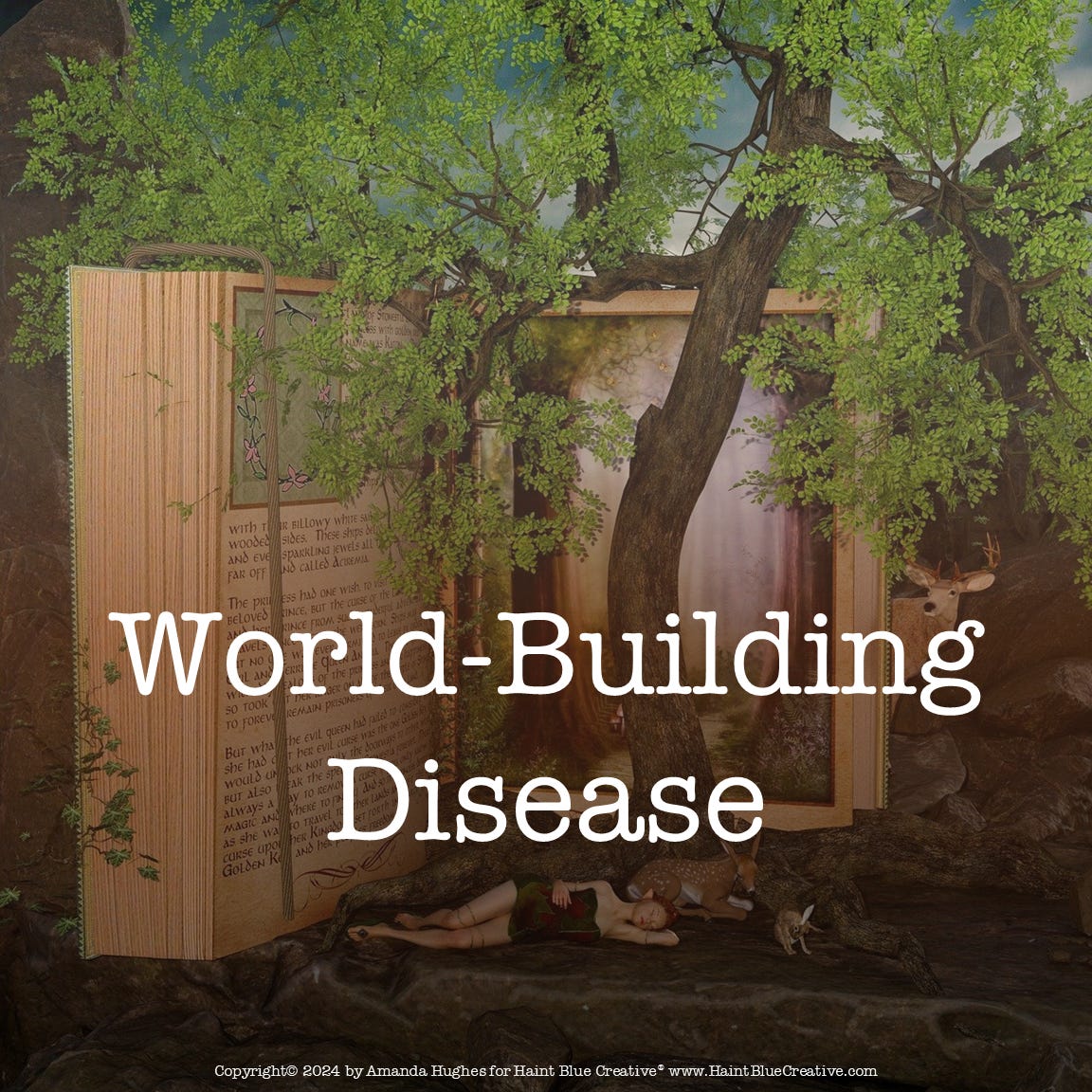On October 3rd of this year, 2024, I launched the first part of this #NaNoWriMo Support Series and provided writers and potential NaNoWriMo* participants with a Novel Writing Checklist.
If you missed that article and free checklist, click here to read and access your copy.
This Novel Writing Checklist offered 11 considerations to make when planning to pen your first draft. These included starting with charting your goals, setting aside time to accomplish them, brainstorming your story idea, identifying the type of project you want to write (novel or novella, for example) and the possible genre(s) in which it might fit, and then developing your characters.
After designing your characters, they’ll need a place to live—your story’s setting—which includes one of my favorite aspects of the book-writing process: world-building.
In Part 6 of this #NaNoWriMo Support Series, I’m sharing everything you need to know in order to map out a world where your story and its characters can make an immersive, page-turning home.
What is world-building and why is it important?
In fiction writing, world-building is the process of constructing the setting, imagined or based on real-world locations, where your story will take place. From Wonderland to Wakanda, Narnia to Neverland, some of the best works of literature include worlds designed entirely from the minds of their authors.
World-building is also important for writers of historical fiction and other types of fiction that take place in real-world settings, as the reader will become more immersed within a story when they can see it rise to life from its pages.
What does excellent world-building include?
To answer this question, I thought I might create another helpful checklist. If you’d like a downloadable copy, simply click or tap on the button above.
A Compelling Storyline—Be sure to consider details such as your story’s tone, mood, and conflict. Is there enough happening along the hero/heroine’s journey to keep your reader’s attention? Is the conflict relatable and believable... or even more enthralling, is it unbelievable?
Believable and Relatable Characters—Speaking of believability, how will the reader relate to your protagonist(s) and antagonist(s)? Show character growth over time. How does the story, environment, and other characters affect them across the storyline? Be careful, however, with harmful tropes and stereotypes. While you’ll want to remain consistent, you don’t want to unintentionally offend your readers.
Setting/Environment—How will you describe the environment? While drafting your story, consider drafting maps, either created by you, an artist, or a map-making app. Having visual aids on hand can not only help with showing your story but maps can be excellent bonus content you can use for incentives such as reader magnets and merch.
Language—Speaking of showing your story, language is important for world-building not only in description and character dialog, but also consider nonverbal language. What are your characters saying without actually saying words? What messages are being relayed in how they’re behaving? What colors, animals, objects, and other symbolism can you include to help show your story and connect the reader to its known and underlying themes?
Culture—What systems are in place that provide foundations and organization in your world? Consider social structure, ethics, rules, laws, religion, technology, economics, language, dialect, and magical systems. Building culture within your world helps enrich your characters, connecting them with the story and your readers.
History—As you’re exploring the culture of your story, also think about back story. How did the world come to be? What are the histories that shaped the environment(s) and structure(s) in which your characters live and interact?
Consistency and Physics— It’s also distracting when the world is inconsistently written. Be mindful of consistent tone, atmosphere, and sneaky little red herrings. According to Sir Isaac Newton, what goes up must come down, and every action garners an equal or opposite reaction. These Laws serve true both in the real world and in fictional environments. As you’re writing, keep track of how your characters move within the constructs of their world to be sure they remain consistent both in appearance and action... unless, of course, an action changes their appearance.
Another distraction that can happen while planning your story’s environment is falling victim to the dreaded world-building disease.
When is too much world-building a distraction?
World-building disease looks like spending too much time describing a scene and/or every little move a character makes to the point that these details veer from the story causing the reader to become lost or bored. For example, fantasy fiction relies on the reader having an in-depth understanding of the scenes so they can imagine themselves as the characters and/or the third-person glimpsing into their story. Romance, on the other hand, needs more character and action description but less about the world around them, especially when it doesn’t lend to the story.
Genre can be an important determining factor regarding how much world-building is needed, so be sure you are crystal clear about what type of story you’re writing before mapping the environment.
How to get inspired
Research methods and the accessibility of such can look different for each writer; however, in order to create the most believable world for your storyline, planning ahead is essential.
While I love to travel and make notes about the stories I’m writing while I’m away, traveling is expensive, and as much as I love it, I can’t stay on-the-go as much as I’d like. As such, I’ve found the next best things to physical travel:
Reading books and watching movies set in a similar genre as your story, of course. And library cards are free in many places.
Search Google Maps, using the Street View feature to virtually venture through real-world places that might inspire your fictional environment.
Build a vision board on Pinterest, using the images to help you write how your story’s environment might appear in the mind’s eye of your readers.
SHOW, Don’t Tell
It’s age-old writerly advice, and I reference it all the time because I believe in the importance of readers having an immersive experience. As you’re transferring your notes into description and dialogue, remember to show your story, rather than telling it. Add descriptive language to your world-building that resonates how the environment looks, feels, sounds, smells, and tastes.
If you’d like help showing your story, I’ve designed a Sensory Story-SHOWing Tarot Activity, included in my new book Mystic Storyteller: A Writer’s Guide to Using the Tarot for Creative Inspiration.
What in the World-Building am I missing?
What are your methods and considerations while writing your fiction worlds? Share in the comments! I’d love to hear what works for other writers.
About Mandy
Amanda “Mandy” Hughes is an author and instructional designer who uses the tarot to inspire storytelling. Her book Mystic Storyteller: A Writer’s Guide to Using the Tarot for Creative Inspiration and companion tarot deck are coming soon! She also writes fiction under pen names A. Lee Hughes and Mandy Lee. Mandy lives in Georgia with her husband and four sons, two of whom are furrier than the others (but not by much). Visit her website at www.haintbluecreative.com and follow her on Instagram @HaintBlueCreative.









This is WONDERFUL!